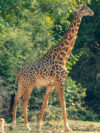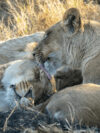Camera Traps in Luambe National Park
Tags: Research, Zambia
Implementing Partner: Zambian Carnivore Programme
Basic faunal data on Luambe National Park is scarce and only a few publications focus on the ecology of the protected area and the surrounding Game Management Areas (GMA). In order to obtain information about the diversity of mammals and in particular the stock of large carnivores in the Luambe National Park, a monitoring study was initiated in cooperation with the Zambian Carnivore Program (ZCP) which, with the help of camera traps, recorded all mammals, especially the occurrence of large carnivores such as leopards, lions , hyenas and wild dogs in the park.
For this purpose, more than 30 camera traps were installed in the western part of the national park and in the area of Luambe Camp from August 2016 to December 2019. The total area of the park covered by camera traps is about 32 km². The camera traps in and around the camp were active from sunrise to sunset, those in the park for 24 hours.
Camera traps were installed at 28 different locations in Luambe National Park. A total of 32 species were identified. Impala, African elephant, hippo and warthog were among the most detected species. Among the predators, the spotted hyena was the most frequently recorded species, while wild dogs were only recorded twice in total during the study period.
A total of 6 camera traps were set up at Luambe Camp. A total of 21 species were identified. Neither giraffes nor wild dogs were recorded near Luambe Camp. With 194 photographs, the leopard turned out to be the species with the most recorded species. Lions were documented more than twice as often in the camp compared to Luambe National Park.



